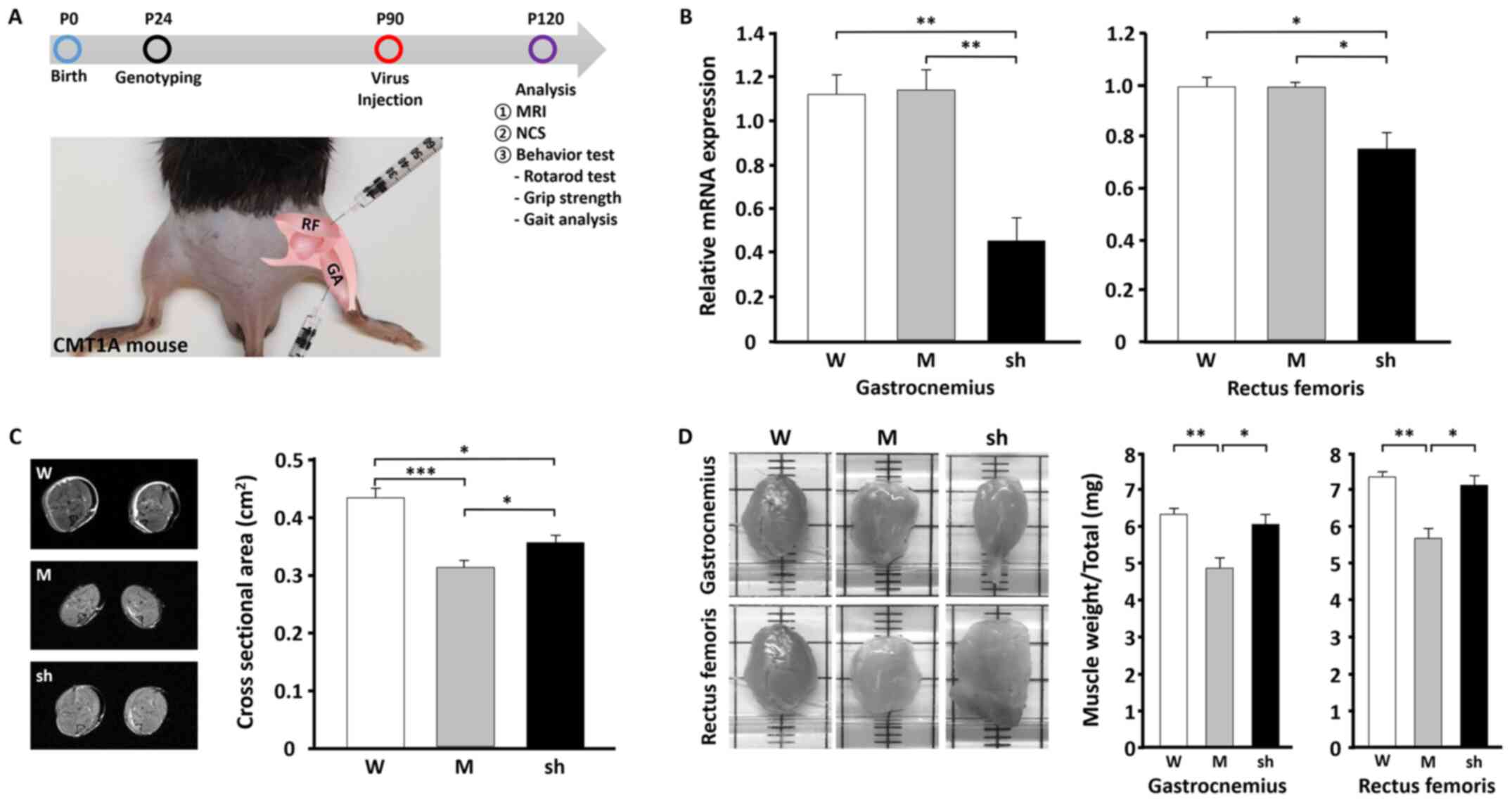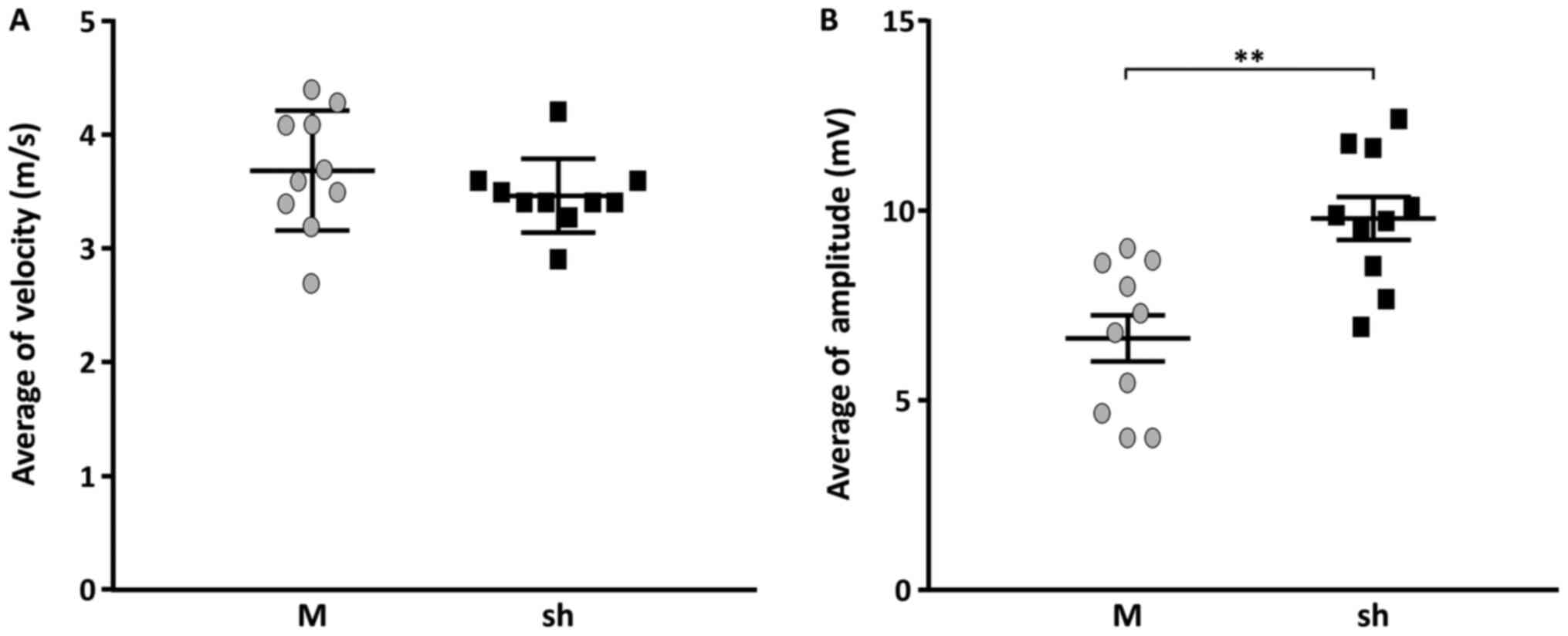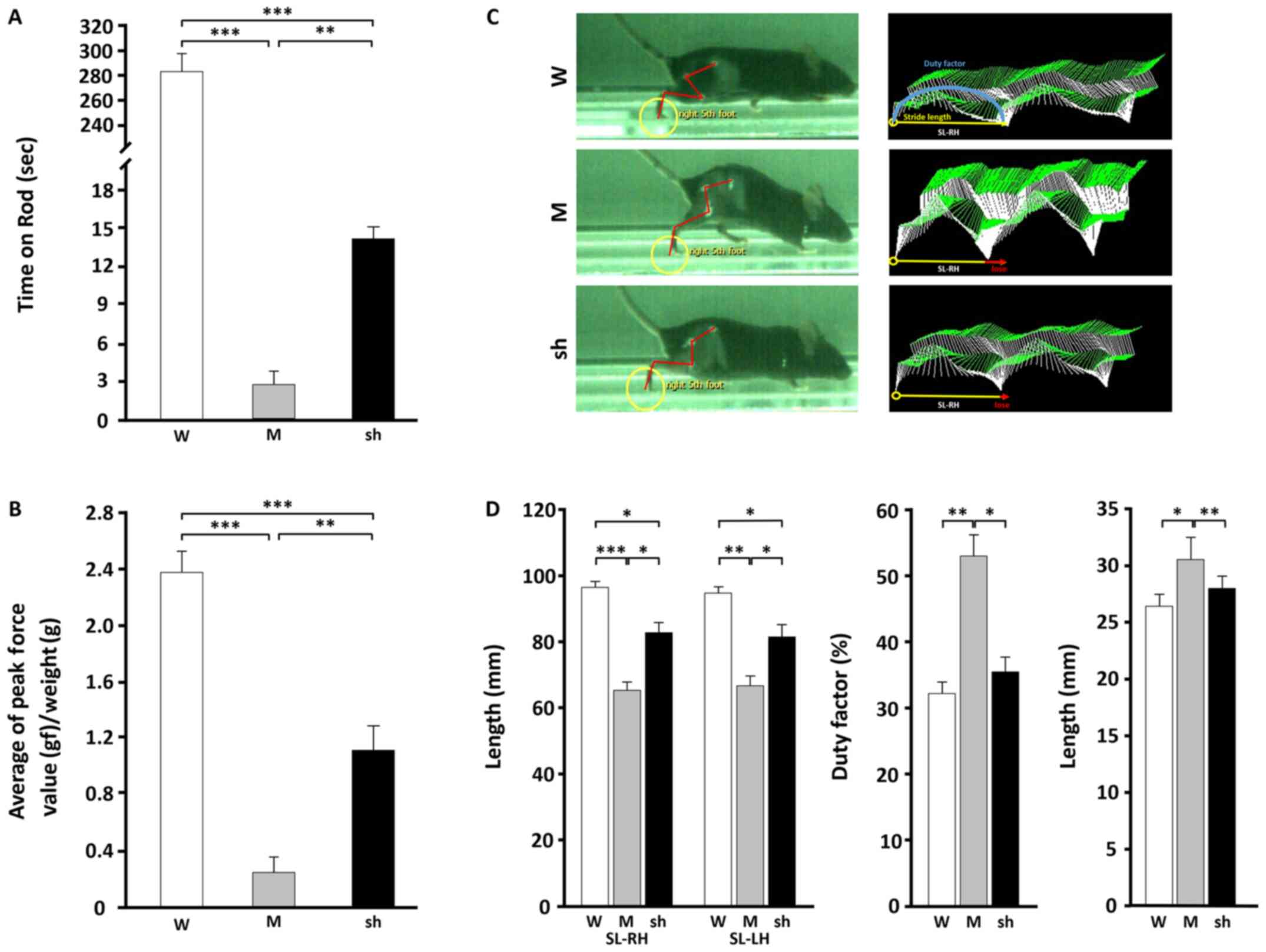|
1
|
Skre H: Genetic and clinical aspects of
Charcot-Marie-Tooth's disease. Clin Genet. 6:98–118. 1974.
View Article : Google Scholar : PubMed/NCBI
|
|
2
|
Levitan IB and Kaczmarek LK: Intercellular
Communication. The Neuron: Cell and Molecular Biology. 4th edition.
Oxford University Press; New York, NY: pp. 153–328. 2015,
View Article : Google Scholar
|
|
3
|
Rotthier A, Baets J, Timmerman V and
Janssens K: Mechanisms of disease in hereditary sensory and
autonomic neuropathies. Nat Rev Neurol. 8:73–85. 2012. View Article : Google Scholar : PubMed/NCBI
|
|
4
|
Rossor AM, Kalmar B, Greensmith L and
Reilly MM: The distal hereditary motor neuropathies. J Neurol
Neurosurg Psychiatr. 83:6–14. 2012. View Article : Google Scholar
|
|
5
|
Harding AE and Thomas PK: The clinical
features of hereditary motor and sensory neuropathy types I and II.
Brain. 103:259–280. 1980. View Article : Google Scholar : PubMed/NCBI
|
|
6
|
Kim JY, Woo SY, Hong YB, Choi H, Kim J,
Choi H, Mook-Jung I, Ha N, Kyung J, Koo SK, et al: HDAC6 inhibitors
rescued the defective axonal mitochondrial movement in motor
neurons derived from the induced pluripotent stem cells of
peripheral neuropathy patients with HSPB1 mutation. Stem Cells Int.
2016:94759812016. View Article : Google Scholar : PubMed/NCBI
|
|
7
|
Fledrich R, Stassart RM and Sereda MW:
Murine therapeutic models for Charcot-Marie-Tooth (CMT) disease. Br
Med Bull. 102:89–113. 2012. View Article : Google Scholar : PubMed/NCBI
|
|
8
|
Robertson AM, Perea J, McGuigan A, King
RH, Muddle JR, Gabreels-Festen AA, Thomas PK and Huxley C:
Comparison of a new pmp22 transgenic mouse line with other mouse
models and human patients with CMT1A. J Anat. 200:377–390. 2002.
View Article : Google Scholar : PubMed/NCBI
|
|
9
|
Meyer zu Horste G, Prukop T, Liebetanz D,
Mobius W, Nave KA and Sereda MW: Antiprogesterone therapy uncouples
axonal loss from demyelination in a transgenic rat model of CMT1A
neuropathy. Ann Neurol. 61:61–72. 2007. View Article : Google Scholar : PubMed/NCBI
|
|
10
|
Sereda MW, Meyer zu Horste G, Suter U,
Uzma N and Nave KA: Therapeutic administration of progesterone
antagonist in a model of Charcot-Marie-Tooth disease (CMT-1A). Nat
Med. 9:1533–1537. 2003. View
Article : Google Scholar : PubMed/NCBI
|
|
11
|
Passage E, Norreel JC, Noack-Fraissignes
P, Sanguedolce V, Pizant J, Thirion X, Robaglia-Schlupp A,
Pellissier JF and Fontes M: Ascorbic acid treatment corrects the
phenotype of a mouse model of Charcot-Marie-Tooth disease. Nat Med.
10:396–401. 2004. View
Article : Google Scholar : PubMed/NCBI
|
|
12
|
Lee JS, Kwak G, Kim HJ, Park HT, Choi BO
and Hong YB: MiR-381 attenuates peripheral neuropathic phenotype
caused by overexpression of PMP22. Exp Neurobiol. 28:279–288. 2019.
View Article : Google Scholar : PubMed/NCBI
|
|
13
|
Lee JS, Lee JY, Song DW, Bae HS, Doo HM,
Yu HS, Lee KJ, Kim HK, Hwang H, Kwak G, et al: Targeted PMP22
TATA-box editing by CRISPR/Cas9 reduces demyelinating neuropathy of
Charcot-Marie-Tooth disease type 1A in mice. Nucleic Acids Res.
48:130–140. 2020.PubMed/NCBI
|
|
14
|
Robaglia-Schlupp A, Pizant J, Norreel JC,
Passage E, Saberan-Djoneidi D, Ansaldi JL, Vinay L,
Figarella-Branger D, Levy N, Clarac F, et al: PMP22 overexpression
causes dysmyelination in mice. Brain. 125:2213–2221. 2002.
View Article : Google Scholar : PubMed/NCBI
|
|
15
|
McPherron AC, Lawler AM and Lee SJ:
Regulation of skeletal muscle mass in mice by a new TGF-beta
superfamily member. Nature. 387:83–90. 1997. View Article : Google Scholar : PubMed/NCBI
|
|
16
|
Lee SJ and McPherron AC: Regulation of
myostatin activity and muscle growth. Proc Natl Acad Sci USA.
98:9306–9311. 2001. View Article : Google Scholar : PubMed/NCBI
|
|
17
|
Mariot V, Joubert R, Hourde C, Feasson L,
Hanna M, Muntoni F, Maisonobe T, Servais L, Bogni C, Le Panse R, et
al: Downregulation of myostatin pathway in neuromuscular diseases
may explain challenges of anti-myostatin therapeutic approaches.
Nat Commun. 8:18592017. View Article : Google Scholar : PubMed/NCBI
|
|
18
|
Wagner KR, McPherron AC, Winik N and Lee
SJ: Loss of myostatin attenuates severity of muscular dystrophy in
mdx mice. Ann Neurol. 52:832–836. 2002. View Article : Google Scholar : PubMed/NCBI
|
|
19
|
Holzbaur EL, Howland DS, Weber N, Wallace
KE, She Y, Kwak S, Tchistiakova LA, Murphy E, Hinson J, Karim R, et
al: Myostatin inhibition slows muscle atrophy in rodent models of
amyotrophic lateral sclerosis. Neurobiol Dis. 23:697–707. 2006.
View Article : Google Scholar : PubMed/NCBI
|
|
20
|
Hennebry A, Oldham J, Shavlakadze T,
Grounds MD, Sheard P, Fiorotto ML, Falconer S, Smith HK, Berry C,
Jeanplong F, et al: IGF1 stimulates greater muscle hypertrophy in
the absence of myostatin in male mice. J Endocrinol. 234:187–200.
2017. View Article : Google Scholar : PubMed/NCBI
|
|
21
|
Dorman CW, Krug HE, Frizelle SP,
Funkenbusch S and Mahowald ML: A comparison of DigiGait™ and
TreadScan™ imaging systems: Assessment of pain using gait analysis
in murine monoarthritis. J Pain Res. 7:25–35. 2013.PubMed/NCBI
|
|
22
|
Xu Y, Tian N, Bai Q, Chen Q, Sun XH and
Wang Y: Gait assessment of pain and analgesics: Comparison of the
DigiGait™ and CatWalk™ gait imaging systems. Neurosci Bull.
35:401–418. 2019. View Article : Google Scholar : PubMed/NCBI
|
|
23
|
Mancuso R, Olivan S, Osta R and Navarro X:
Evolution of gait abnormalities in SOD1(G93A) transgenic mice.
Brain Res. 1406:65–73. 2011. View Article : Google Scholar : PubMed/NCBI
|
|
24
|
DiGiusto DL, Krishnan A, Li L, Li H, Li S,
Rao A, Mi S, Yam P, Stinson S, Kalos M, et al: RNA-based gene
therapy for HIV with lentiviral vector-modified CD34(+) cells in
patients undergoing transplantation for AIDS-related lymphoma. Sci
Transl Med. 2:36ra432010. View Article : Google Scholar : PubMed/NCBI
|
|
25
|
Maples PB, Kumar P, Yu Y, Wang Z, Jay C,
Pappen BO, Rao DD, Kuhn J, Nemunaitis J and Senzer N: FANG Vaccine:
Autologous tumor cell vaccine genitically modified to express
GM-CSF and block production of furin. BioProcess J. 8:4–14. 2009.
View Article : Google Scholar
|
|
26
|
Livak KJ and Schmittgen TD: Analysis of
relative gene expression data using real-tie quantitative PCR and
the 2(-Delta Delta C(T)) method. Methods. 25:402–408. 2001.
View Article : Google Scholar : PubMed/NCBI
|
|
27
|
Hasenberg A, Hasenberg M, Männ L, Neumann
F, Borkenstein L, Stecher M, Kraus A, Engel DR, Klingberg A,
Seddigh P, et al: Catchup: A mouse model for imaging-based tracking
and modulation of neutrophil granulocytes. Nat Methods. 12:445–452.
2015. View Article : Google Scholar : PubMed/NCBI
|
|
28
|
Boivin GP, Hickman DL, Creamer-Hente MA,
Pritchett-Corning KR and Bratcher NA: Review of CO2 as a
euthanasia agent for laboratory rats and mice. J Am Assoc Lab Anim
Sci. 56:491–499. 2017.PubMed/NCBI
|
|
29
|
Marquardt N, Feja M, Hünigen H, Plendl J,
Menken L, Fink H and Bert B: Euthanasia of laboratory mice: Are
isoflurane and sevoflurane real alternatives to carbon dioxide?
PLoS One. 13:e02037932018. View Article : Google Scholar : PubMed/NCBI
|
|
30
|
Makowska IJ and Weary DM: Rat aversion to
induction with inhalant anaesthetics. Appl Anim Behav Sci.
119:229–235. 2009. View Article : Google Scholar
|
|
31
|
Leach MC, Bowell VA, Allan TF and Morton
DB: Degrees of aversion shown by rats and mice to different
concentrations of inhalational anaesthetics. Vet Rec. 150:808–815.
2002. View Article : Google Scholar : PubMed/NCBI
|
|
32
|
Verhamme C, King RH, ten Asbroek AL,
Muddle JR, Nourallah M, Wolterman R, Baas F and van Schaik IN:
Myelin and axon pathology in a long-term study of
PMP22-overexpressing mice. J Neuropathol Exp Neurol. 70:386–398.
2011. View Article : Google Scholar : PubMed/NCBI
|
|
33
|
Komyathy K, Neal S, Feely S, Miller LJ,
Lewis RA, Trigge G, Siskind CE, Shy ME and Ramchandren S: Anterior
tibialis CMAP amplitude correlations with impairment in CMT1A.
Muscle Nerve. 47:493–496. 2013. View Article : Google Scholar : PubMed/NCBI
|
|
34
|
Stojkovic T: Hereditary neuropathies: An
update. Rev Neurol (Paris). 172:775–778. 2016. View Article : Google Scholar : PubMed/NCBI
|
|
35
|
Lee JS, Chang EH, Koo OJ, Jwa DH, Mo WM,
Kwak G, Moon HW, Park HT, Hong YB and Choi BO: Pmp22 mutant
allele-specific siRNA alleviates demyelinating neuropathic
phenotype in vivo. Neurobiol Dis. 100:99–107. 2017. View Article : Google Scholar : PubMed/NCBI
|
|
36
|
Chal J and Pourquie O: Making muscle:
Skeletal myogenesis in vivo and in vitro. Development.
144:2104–2122. 2017. View Article : Google Scholar : PubMed/NCBI
|
|
37
|
McPherron AC and Lee SJ: Double muscling
in cattle due to mutations in the myostatin gene. Proc Natl Acad
Sci USA. 94:12457–12461. 1997. View Article : Google Scholar : PubMed/NCBI
|
|
38
|
Grobet L, Martin LJ, Poncelet D, Pirottin
D, Brouwers B, Riquet J, Schoeberlein A, Dunner S, Menissier F,
Massabanda J, et al: A deletion in the bovine myostatin gene causes
the double-muscled phenotype in cattle. Nat Genet. 17:71–74. 1997.
View Article : Google Scholar : PubMed/NCBI
|
|
39
|
Kambadur R, Sharma M, Smith TP and Bass
JJ: Mutations in myostatin (GDF8) in double-muscled Belgian blue
and piedmontese cattle. Genome Res. 7:910–916. 1997. View Article : Google Scholar : PubMed/NCBI
|
|
40
|
Grobet L, Poncelet D, Royo LJ, Brouwers B,
Pirottin D, Michaux C, Menissier F, Zanotti M, Dunner S and Georges
M: Molecular definition of an allelic series of mutations
disrupting the myostatin function and causing double-muscling in
cattle. Mamm Genome. 9:210–213. 1998. View Article : Google Scholar : PubMed/NCBI
|
|
41
|
Lin J, Arnold HB, Della-Fera MA, Azain MJ,
Hartzell DL and Baile CA: Myostatin knockout in mice increases
myogenesis and decreases adipogenesis. Biochem Biophys Res Commun.
291:701–706. 2002. View Article : Google Scholar : PubMed/NCBI
|
|
42
|
Pearsall RS, Davies MV, Cannell M, Li J,
Widrick J, Mulivor AW, Wallner S, Troy ME, Spaits M, Liharska K, et
al: Follistatin-based ligand trap ACE-083 induces localized
hypertrophy of skeletal muscle with functional improvement in
models of neuromuscular disease. Sci Rep. 9:113922019. View Article : Google Scholar : PubMed/NCBI
|
|
43
|
Bonnefoy A and Armand S: Normal Gait.
Orthopedic Management of Children With Cerebral Palsy: A
Comprehensive Approach. Nova Science Publishers Inc.; Hauppauge,
NY: pp. 5672015
|
|
44
|
Chester VL, Biden EN and Tingley M: Gait
analysis. Biomed Instrum Technol. 39:64–74. 2005.PubMed/NCBI
|


















